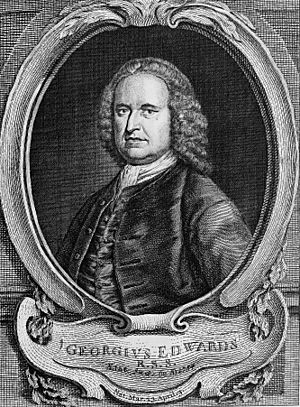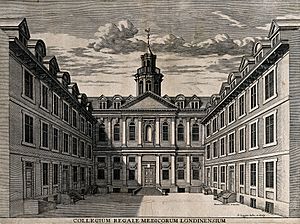George Edwards (naturalist) facts for kids
Quick facts for kids
George Edwards
|
|
|---|---|

Engraving by John Miller after a portrait painted in 1754 by Bartholomew Dandridge
|
|
| Born | 3 April 1694 West Ham, then Essex, now London, England
|
| Died | 23 July 1773 (aged 79) |
| Known for | Natural history writings and illustrations, A Natural History of Uncommon Birds |
| Awards | Copley Medal of the Royal Society |
| Scientific career | |
| Fields | Naturalist, ornithologist |
| Institutions | Royal College of Physicians |
| Influenced | Carl Linnaeus |
George Edwards (born April 3, 1694 – died July 23, 1773) was an English naturalist and ornithologist. He is often called the "father of British ornithology" because of his important work studying birds.
Edwards was born in West Ham, which was then a part of Essex. When he was young, he traveled a lot around Europe. He studied natural history and became well-known for his colorful drawings of animals, especially birds. In 1733, he got a job at the Royal College of Physicians.
Over 21 years, Edwards published seven books filled with descriptions and hand-colored pictures of birds. He also drew a few other animals. None of the animals he drew were from Britain. His first four books, called A Natural History of Uncommon Birds, came out between 1743 and 1751. The next three books, called Gleanings Of Natural History, were published from 1758 to 1764. In total, his books have 362 hand-colored pictures, with 317 of them showing birds. George Edwards drew all the pictures himself.
The famous Swedish naturalist Carl Linnaeus used Edwards's books. When Linnaeus updated his book Systema Naturae in 1758, he used Edwards's descriptions and pictures for many birds. This helped Linnaeus give scientific names to many species.
Edwards became a member of the important Royal Society in 1757. He never married and passed away in 1773 at the age of 79 in Plaistow, Essex.
Contents
George Edwards's Early Life and Travels
George Edwards was born on April 3, 1694, in Stratford. This area was then a small part of West Ham in Essex. He had two sisters, Ann and Mary, and a half-brother named James Frost. Around age six, he went to a boarding school in Leytonstone, and later to Brentwood Grammar School.
His parents wanted him to become a merchant. So, after school, he started working for John Dod in London. Dod had a large collection of books. Edwards loved reading these books, and they made him want to travel instead of working in business.
In August 1716, after seven years with Dod, Edwards left London for Holland. He spent two months visiting many big cities there. For the next two years, he was back in England without a job.
In 1718, a merchant friend invited him to join a ship going to Norway. He stayed for two months in Frederikshald (now Halden), near the border with Sweden. This was during the Great Northern War, so he couldn't travel much. Once, he was even arrested because people thought he was a Swedish spy! He returned to England by ship to Bristol, then traveled to London.
In May 1719, he left England again. He went through Dieppe to Paris. He found Paris too expensive, so he moved to Guyancourt, a village near Versailles. From there, he took two walking trips. One was to Châlons-en-Champagne with his host's son. The other was to Orléans and Blois. On this trip, he dressed like a poor traveler to avoid robbers. After almost two years in France, he returned to London in January 1721. Later that year, he visited Newcastle upon Tyne with the same merchant who took him to Norway.
Working at the Royal College of Physicians
In 1733, George Edwards got a job at the Royal College of Physicians in London. This happened because Hans Sloane recommended him. Edwards became the "beadle" of the college. The beadle was like the main manager and was in charge of the college's property.
Edwards also called himself the "librarian" because one of his jobs was to take care of the library. Sir Hans Sloane, who started the British Museum, had hired Edwards before to draw animals for him. Edwards would visit Sloane once a week to share news and have coffee. Sloane paid Edwards for his drawing expenses every year.
Edwards worked as the college librarian for 36 years. He was also chosen to be a member of the Royal Society and the London Society of Antiquaries.
Edwards's Ornithology Books
In 1743, Edwards published the first part of his book A Natural History of Uncommon Birds. The fourth part came out in 1751. The books were printed for him at the College of Physicians. At the same time, a French version of the book was also published.
Later, he published three more books called Gleanings of Natural History. These came out in 1758, 1760, and 1764. Together, these two sets of books have pictures and descriptions of more than 600 different animals and plants that had not been shown before. Edwards also made an index in French and English. Carl Linnaeus himself later added the scientific names to this index.
The Royal Society gave Edwards the Copley Medal in 1750. This award was for his "very curious Book" called A Natural History of Birds. The medal recognized his elegant drawings and colored pictures of 209 different birds and about 20 rare mammals and snakes. This was a very important award. For example, the year before, John Harrison won it for inventing a special clock to find longitude at sea. Edwards was so proud that he put a picture of the medal on the title page of his first book.
Around 1764, he retired to Plaistow, Essex, which was still a quiet village. He passed away there at 77 years old. He also wrote a book called Essays of Natural History in 1770.
A German engraver named Johann Michael Seligmann saw how popular Edwards's and Mark Catesby's illustrated books were. So, he re-etched all 474 of their original pictures. These were published with German text in nine books between 1749 and 1776. The German text was also translated into French and Dutch.
Some of the colored pictures in his Natural History of Birds were painted by Peter Paillou.
Animals Named After George Edwards
Some animals have been named in honor of George Edwards.
- The snake Diadophis punctatus edwardsii, a type of North American snake, is named after him.
- The puffadder shyshark, which Edwards first described in 1760, is now called Haploblepharus edwardsii.
Gallery
-
Plate 5: "The Black Parrot from Madagascar" now the lesser vasa parrot (Coracopsis nigra)
-
Plate 23: "The Red-Headed Green-Finch" now the bay-headed tanager (Tangara gyrola)
-
Plate 117: "The Long-tailed Grous from Hudson's-Bay" now the sharp-tailed grouse (Tympanuchus phasianellus)
-
Plate 123: "The Greatest Bulfinch-Cock" now the pine grosbeak (Pinicola enucleator)
Works
- A Natural History of Uncommon Birds (1743-1751)
- Gleanings of Natural History (1758-1764)
- Essays of Natural History (1770)
See also
 In Spanish: George Edwards para niños
In Spanish: George Edwards para niños






